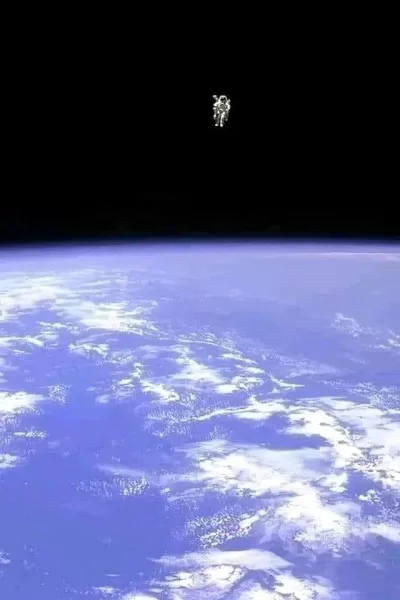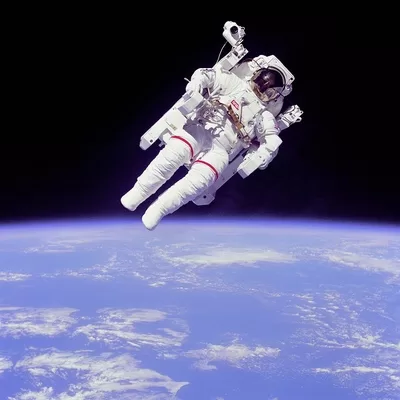In the vast expanse of space, where humanity’s imagination meets the stark reality of cosmic vacuum, exists a realm of unparalleled adventure and risk. Among the brave souls who dared to venture into this void, Bruce McCandless stands out as a true pioneer, etching his name in the annals of space exploration with an act of unprecedented courage and innovation: the first-ever untethered spacewalk.
In February 1984, during the STS-41-B mission of the Space Shuttle Challenger, astronaut McCandless took a step that would redefine the boundaries of human capability and redefine what it meant to walk in space.
Armed with the Manned Maneuvering Unit (MMU), a jet-powered backpack designed to provide astronauts with unparalleled freedom of movement, McCandless ventured out into the cosmic abyss, detached from the safety of the shuttle’s tether.

The image of McCandless, floating freely against the backdrop of Earth’s curvature, encapsulates the essence of human ingenuity and the relentless pursuit of exploration. With the MMU, he soared over 300 feet away from the shuttle, becoming the first human satellite, a testament to the indomitable spirit of human curiosity.
“This photograph, taken by Robert Gibson from the shuttle, is beautiful, partly because the sun is shining directly on me. That’s why I have my visor down (although if you look closely, you can make out a few of my features). It’s also one of its attractions: my anonymity means people can imagine themselves doing the same thing. At visitor centres, they often have life-sized cardboard versions with the visor cut out, so people can peep through. Like Neil said in 1969, I was representing mankind up there,” Bruce McCandless wrote.
“The iconic photo of Bruce soaring effortlessly in space has inspired generations of Americans to believe that there is no limit to the human potential” senator John McCain said.
But McCandless’s spacewalk was more than just a feat of engineering or a display of technological prowess. It was a moment of profound significance, symbolizing humanity’s quest to transcend the limits of our terrestrial existence and reach out into the cosmos.
In that fleeting moment, McCandless embodied the aspirations of countless dreamers and visionaries who dared to imagine a future among the stars.
“I don’t like those overused lines “slipped the surly bonds of Earth”, but when I was free from the shuttle, they felt accurate. It was a wonderful feeling, a mix of personal elation and professional pride: it had taken many years to get to that point. Several people were sceptical it would work, and with 300 hours of flying practice, I was over-trained. My wife was at mission control, and there was quite a bit of apprehension. I wanted to say something similar to Neil [Armstrong] when he landed on the moon, so I said, “It may have been a small step for Neil, but it’s a heck of a big leap for me.” That loosened the tension a bit” Bruce McCandless said.
“I’d been told of the quiet vacuum you experience in space, but with three radio links saying, “How’s your oxygen holding out?” “Stay away from the engines!” “When’s my turn?” it wasn’t that peaceful.”
However, McCandless’s spacewalk was not without its risks. Floating in the void of space, untethered and alone, he was vulnerable to the unforgiving environment that surrounded him. Yet, despite the inherent dangers, McCandless remained composed and focused, relying on his training and expertise to navigate the vast expanse of space.
His pioneering spirit and unwavering determination serve as an inspiration to all who dare to dream of reaching beyond the confines of Earth. McCandless’s legacy lives on in every astronaut who ventures into the unknown, pushing the boundaries of human exploration and expanding our understanding of the universe.
On December 21, 2017, at the age of 80, McCandless passed away and was laid to rest at the United States Naval Academy Cemetery in Annapolis.
Manned Maneuvering Unit (MMU)
The Manned Maneuvering Unit (MMU) saw action during three Shuttle missions in 1984, marking a pivotal moment in space exploration. Its inaugural test occurred on February 7 during mission STS-41-B, led by astronauts Bruce McCandless II and Robert L. Stewart.
Two months later, during mission STS-41-C, astronauts James van Hoften and George Nelson endeavored to utilize the MMU to retrieve the Solar Maximum Mission satellite for repairs and servicing. Despite three attempts to grapple the satellite using the TPAD, success eluded them due to an unexpected obstacle: an obstructing grommet not accounted for in the satellite’s blueprints.
The MMU’s final mission took place during STS-51-A in November 1984. This mission showcased the unit’s versatility as it was employed to recover two communication satellites, Westar VI and Palapa B2. These satellites had failed to reach their designated orbits due to faulty propulsion modules. Astronauts Joseph P. Allen and Dale Gardner successfully captured the satellites using the MMU and transported them into the orbiter’s payload bay for stowage and eventual return to Earth.
Following a thorough safety assessment prompted by the Space Shuttle Challenger disaster, the Manned Maneuvering Unit (MMU) was deemed too hazardous for continued utilization. It was determined that numerous tasks initially earmarked for the MMU could be accomplished efficiently using manipulator arms or conventional tethered extravehicular activities (EVAs).
McCandless’s historic spacewalk
In the decades since McCandless’s historic spacewalk, the spirit of exploration has continued to drive humanity forward, leading to incredible discoveries and achievements in space. From the exploration of Mars to the study of distant exoplanets, we continue to push the limits of what is possible, guided by the pioneering spirit of individuals like Bruce McCandless.
As we look to the future, McCandless’s legacy serves as a reminder of the boundless potential that lies within each of us. In the vast expanse of space, where the stars shine brightly against the backdrop of infinity, there are no limits to what we can achieve. Bruce McCandless showed us that the only true limit is the one we place on ourselves, and that with courage, determination, and a pioneering spirit, we can reach for the stars and beyond.


Related stories
NASA’s Famous Blue Marble Photo Is 50 Years Old
Lunar Agriculture: Plants to be Grown on the Moon
Best way to reduce climate change is stop gas industry methane
Sarah Moon, French fashion photographer
Moonwalk to Immortality: The Michael Jackson Story
The Future of Celebrations: Will Drones Replace Fireworks?
Solar race cars overcome head winds at World Solar Challenge
Proof that weather modification exists






